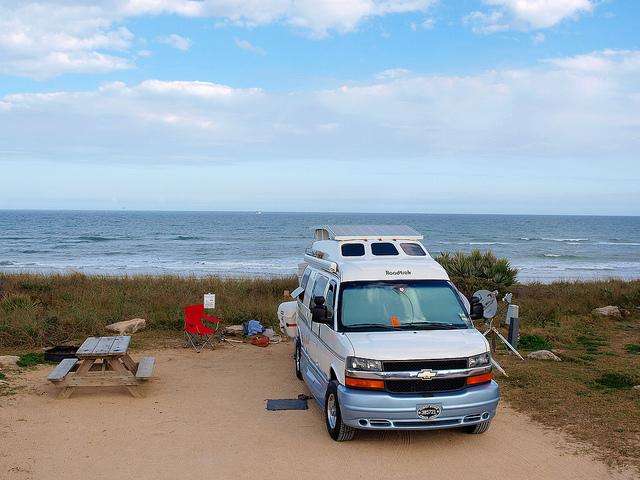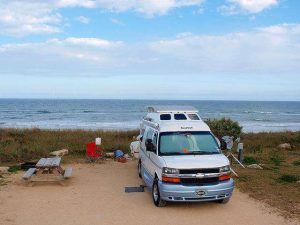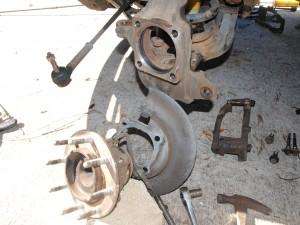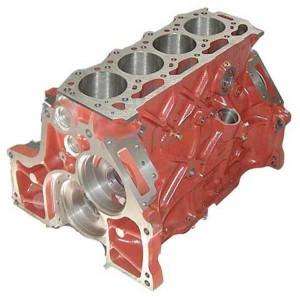Winterizing – It’s Not as Complicated as It Seems

Few RV subjects get as much scrutiny and exhaustive analysis as winterizing – protecting your plumbing from freezing when you store your RV for the winter, or just want to take it into freezing conditions. Here's my take on it.

I'm not an expert on winterizing – as a matter of fact, I winterized for the first and only time a few weeks ago. Normally I'm where the sun shines and the warm breezes blow, and don't have to winterize. I do know a bit about RV plumbing, though, enough to be convinced that I don't want to do any more of it than absolutely necessary. RV plumbing is a mess. The pipes are plastic, it's all hidden behind the cabinets and other permanently installed fixtures in your RV, and once it's messed up it's very hard to repair. I want my plumbing to live long and prosper so I can spend my time staring out over the ocean and thinking deep thoughts, not crawling around inside my cabinets, busting knuckles and getting frustrated.

There are a few simple principles I have discovered in my 40 years of mechanicing. The main one is to never take anything apart you don't have to. If it's working, leave it alone. I know it's tedious to flush all the pink antifreeze out of your system in the spring, but taking plastic plumbing fittings loose is a sure way to tempt the vengeance of the gods. They are compression fittings, and the formerly flexible material that made the seal has been baking in the heat and shivering in the cold for lo these many years since the RV was built. You aren't as flexible as you were all those years ago, and neither are your compression fittings. In addition, clean new parts assemble much better than parts that have been sitting at the bottom of a RV cabinet for a long time. They have burrs on them from the original assembly plus whatever more burrs you put on them taking them apart. Dirt gets into the fittings – there are all kinds of things to go wrong. A good, non-leaking fitting depends on two smooth, clean surfaces compressing a smooth, clean flexible material. Unless you're replacing everything, leave it alone. Sooner or later you'll break something.

Air and water are different – I went to school long enough to say that with confidence. Air is compressible, water isn't. As a result, you can blow many cubic feet of air through an air line and still leave water in it – enough water to collect at a low point or bend or fitting and break your pipes when it freezes. Unless you have a dehumidified – not just dry – source of compressed air and blow it through a line for half a hour, you are leaving water in the lines. The only effective mechanism is evaporation, and by the time your lines are dry you will have stressed them so much it will be a miracle if they hold water next year. Water pump diaphragms will flap around wildly as high-speed air goes by them, so any weak spots in them will get damaged as well. Compressed air in your water lines is a very bad idea for the RV owner, despite its appeal to the RV mechanic wanting to take a few shortcuts. He'll be glad to sell you a new water pump next spring, by the way. Water lines and pumps are designed to handle liquids like water and RV antifreeze, which they do very well. Don't ask them to do things they aren't designed to do.
Here's a novel idea – put pink RV antifreeze in the fresh water tank(s) and use the water pump and gravity to circulate it throughout the system. When you see pink antifreeze come out of each faucet, you know for a fact that there's no water in that line. Antifreeze travels through the system just like water does, pushing the water ahead of it. Circulate the pink stuff through your pump return lines by opening the city water valve. Pop the check valve at the city water intake to get all the water out there. See? It's simple. If the idea of pink stuff sitting in your fresh water tank gives you heartburn, drain the tank after you finish winterizing. This revolutionary technique will save you lots of broken plumbing, which is the whole idea of winterizing in the first place. Man, I oughta patent this stuff…

Sure wish we had one of those
I was raised on the beach,
Never even got to use my trailer this summer, but due to trips to the service center for repairs, I will need to drain lines and winterize!
Easiest way is travel some place warmer and keep using it. https://facebook.com/RoadTripWithTheWilkes
แจมด้วย
I need one of those vans know who sells them
its not over yet…
We winterize with brandy and more firewood!
A few of y’all missed the point of the post..lol
I wish I could afford this van it would be a dream come true.
My advise: DRIVE SOUTH
Keep the furnace up!
It’s not that hard people whether u use rv antifreeze our blow system out using low pressure air.
Just pull the heating anode and let tank drain.
Winterizing? Isn’t that when you drive the RV far enough south that you miss all the snow and freezing weather during the winter? 😀
How how hot water heater? How do we winterize that?
Jan, actually you drain the hot water heater and rinse out all the sediment in the bottom.
อาห้า ใครซนเข็นรถของพี่หมอปัญญามาเล่นแถวนี้เนี่ยะ
Just DON”T take it to Camping World!! cost us over 1000$ to have it repaired and they refuse to pay!!!!
Thanks for reinforcing the basics of freeze protection. Wish we could spend the Coles weather months down south but not for a fee years yet.
Keep up the great work!
j adore j en aie un
Ya lost me at the satellite dish
Mark Woodruff
Winterizing is easy: you just head south for the winter 🙂
Roxanne Balderas
What kind of camper is this
My idea of winterizing is heading south!
Thats Gamble Rogers in Flagler Beach Florida! my Home Town! Miss it Mucho
Hay Stephen Allen…stars,campfire,quiet…on the shores of Lake Erie ? Florida ?
RVing soon. Anyone interested ?
So you, carol and Jerome~♥
OMG wish I was there, it snowed here this morning.
I want one of these!
Looks like the state beach area in Carlsbad, CA.
Except for the “”no shade “”thing and the ” need to ditch the satellite ” thing it looks pretty good
Love camping. Anytime anywhere, love it.
My next van….lol
my new dream
I appreciate hearing the voice of experience. Thanks for sharing. Reconfirmed what I have been doing … although I was thinking about trying the air thing with my new air compressor toy … now have rethought that and will keep it simple. Thanks
I though we were not suppose to get RV fluid in the fresh water tank???? Does it not smell???
No, not complicated – just spend the winter in FL and avoid the chore completely!
Please Campskunk consider in your answer that I live in Quebec, Canada where the winter temperature can reach – 30 F
A few more questions:
1) When you say ” Circulate the pink stuff through your pump return lines by opening the city water valve ” I presume it’s with the water pump on and you close it short after, just the time to make sure antifreeze replace water in the dead end. Is it the case?
2) When you say to ” Pop the check valve at the city water intake to get all the water out there ” The water pump off, you probably open a cold water faucet to give an air entry permitting the evacuation of the water until the pink stuff appears. Is it the case?
3) Putting antifreeze In the water traps does not replace the water in but dilute it more and more depending of the volume of antifreeze put in. How much antifreeze do you put in the traps?
4) What about the macerator? How can you make sure there is no more water in it? Do you activate it with antifreeze in the tanks?
When you ” Pop the check valve at the city water intake to get all the water out there ” do you let the water pump on?
no, gravity will drain it on mine. it points straight down. pop it gently – the valve is easily damaged.
Also a good idea to run antifreeze out the external shower if you have one.
It should stay in the lines until you flush in the spring.
What about the drain lines and all the water in the traps? I usually dump a cup of antifreeze in each drain to displace the water so the traps do not freeze and crack.
that’s another thing i do but didn’t mention here. my roadtrek came with a cracked trap on the aisle shower drain – probably freeze damage.
Thank you for this article. You have put into words exactly why I don’t blow out the lines and have no concerns of pink stuff in the fresh water tanks. I should mention (repeat) one other concern I have and that is leaving the water pump empty for extended periods. Drying out the diaphragm just doesn’t seem right to me for some reason. I have done it your way for six years now and have not have a single problem with the plumbing. (I can’t believe I just said that… quickly knocking on wood.)
SO…if you drain all of the antifreeze at the end can you catch the antifreeze to use in other areas? /*
out of the freshwater tank? sure, i don’t see why not. a lot of the stuff you get out of the faucets is going to be diluted, though, with water coming through in front of it from the water lines. pure antifreeze is good to 50 below, so 50% mix with water should be good to -10 or so. it depends on where you are, i guess, but at $4 a gallon for the good stuff i wouldn’t take any unnecessary chances.
Thanks
Put pink stuff in the fresh water tanks, then pump it thru the lines until it comes out of all outlets. So simple even a caveman can do it. Thanks for making this perfectly clear, Campskunk. Another thing perfectly clear is the owners manual for my 06C190P says I can continue Roadtreking in temps down to +14degreesF. We did so for a week last winter in Reno. Rain, snow, ice, and night time temps down to +15-20F. We followed the instructions in the owners manual, threw on an extra blanket, had a great time. Our Roadtrek performed flawlessly and suffered no ill aftereffects whatsoever.
my 190 was good down to 20ish in winter mode, and long as the temperatures bounced back up in the daytime, and you keep the inside warm. winter mode and winterized are two different things, though – if you stop heating it, it will freeze solid just like a summer-only RV. when it looks like it’s going to freeze and i want to keep on camping, i dump my front tank, suck the water out of the line to the front tank with the water pump, clear the outside shower lines, dump the gray and black water tanks and stop using them, and i’m good to go, as long as i run the furnace.
Are there and chances that this technology will go to future E-trek?
dunno how they do the 4 seasons camping stuff yet, so i can’t take an educated guess. not even a semi-educated one. the E-Trek is probably pretty close to the weight limit with all those batteries etc- depends on how much weight the other stuff adds.
And what is the location for the first picture (roadtrek near sea). There is a table, so it is obviously a camp ground?
that’s Gamble Rogers State Recreation Area, a Florida state park facility just north of Daytona Beach. right now it’s probably booked solid until March.
Simple, simple, simple….I love it. Thanks for the reminder!
Does anyone know if it is possible and affordable (most important) to fit heaters to the three tanks, grey, holding, and fresh? Why? Well I’m using the Roadtrek 200 Versatile all year here in western New York, and it’s snowing right now! Someone else MUST have done this?
john, someone did – the 40th anniversary 190 has 4 season capability and is good down to temperatures where it’s just too cold for exposed skin outside. dunno exactly how they do it, but it’s probably not electric heaters on the tanks like the Class As do it – that’s probably 2000 watts to heat uninsulated tanks hanging down underneath the chassis with heat strips. The Class As have to either be plugged in or running the generator all the time.
Amen…….
Thank you. Patent? I don’t know. Print edition? Downloadable PDF edition? Absolutely!